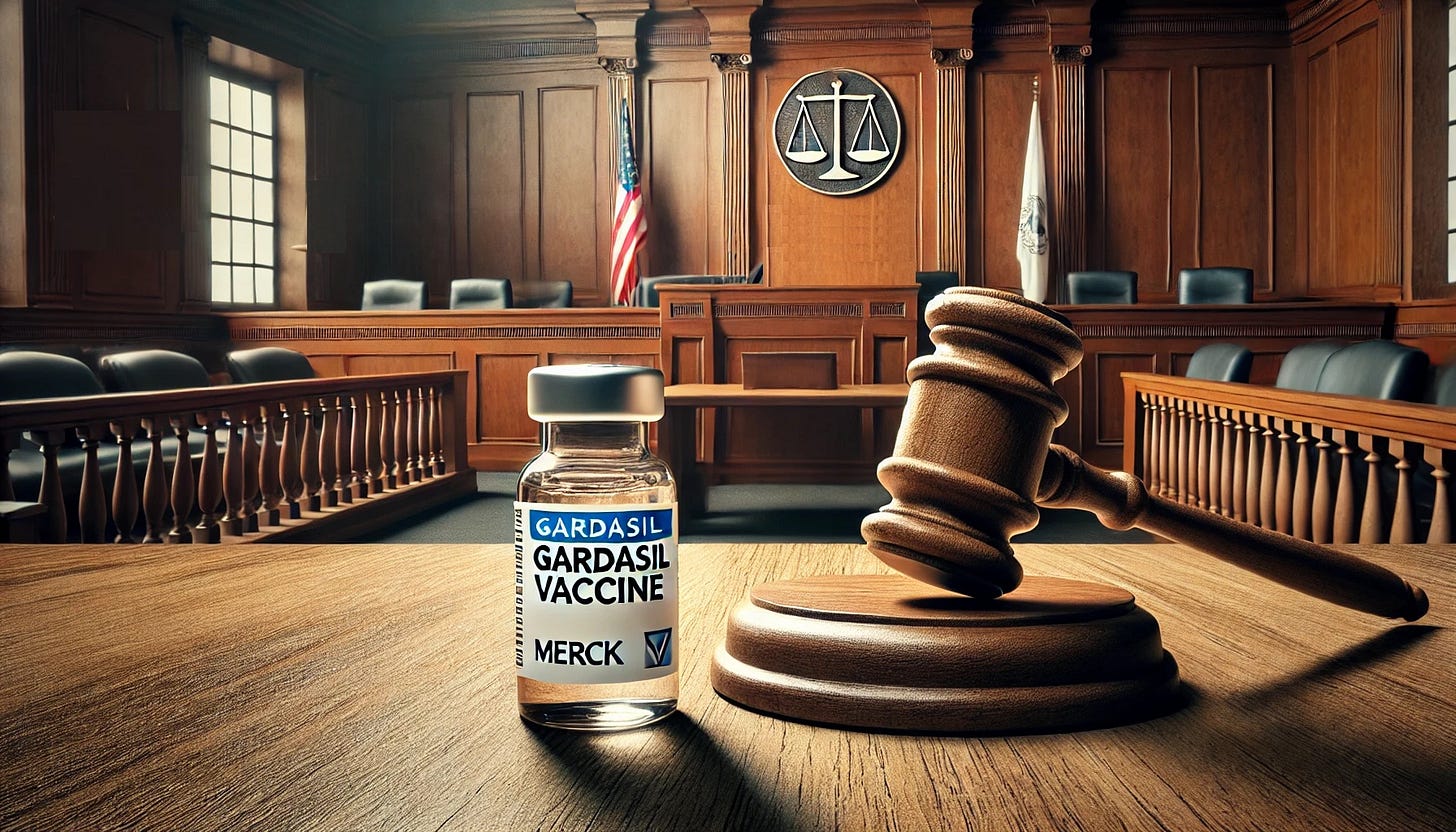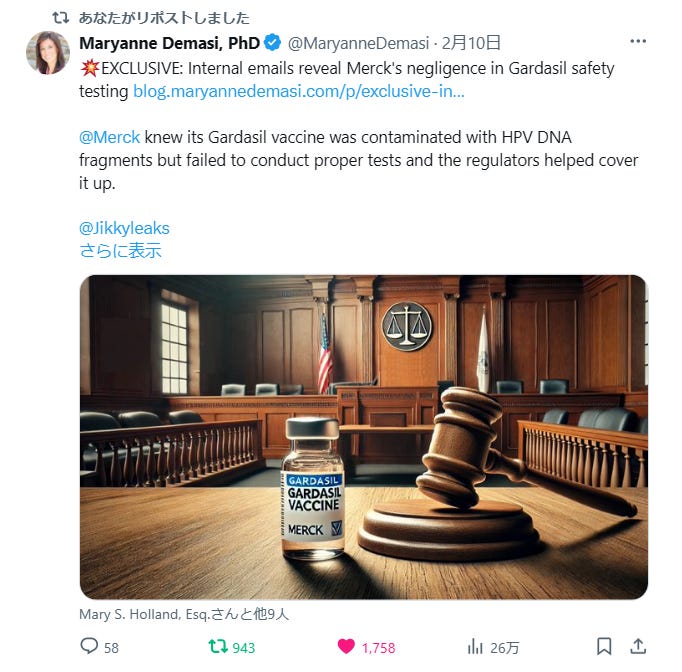Did Merck recognize long ago that residual plasmid DNA binds to aluminum adjuvant AAHS ??
-From Merck Patents
(1) Introduction
Recently, decisive evidence has emerged regarding Merck's HPV vaccine, Gardasil.
Merck knew its Gardasil vaccine was contaminated with HPV DNA fragments but failed to conduct proper tests and the regulators helped cover it up.
https://x.com/MaryanneDemasi/status/1888700984978989526
(2) My Initiative
I reached out to the patent regarding Merck's HPV vaccine for the first time in response to this issue. My interest lies in whether Merck was aware that residual DNA was binding to AAHS.
In Gardasil of Merck, isn’t the surface charge of AAHS fixed at zero or positive to allow VLP (L1 & L2) to adsorb onto it?
In the case of DNA (plasmid DNA), if the surface charge of the adjuvant is negative, the adsorption of negatively charged DNA is likely to be inhibited. Basically, DNA is negatively charged due to phosphate groups and other factors. This is also evident from the principle of electrophoresis, which utilizes the negative charge of DNA.
In the case of Gardasil, the surface charge of AAHS is to be adjusted because VLP has to be adsorbed onto AAHS, and the behavior of DNA towards AAHS accordingly becomes changed.
First, AAHS has positively charged aluminum ions, and due to the bridging effect of aluminum ions, DNA may be more likely to adsorb onto AAHS. Second, if the surface charge of AAHS is adjusted to zero or positive for VLP, then the inhibitory effect on DNA adsorption to AAHS may be reduced or even reversed.
It can be inferred that the tendency for AAHS to bind with DNA increases if the molar ratio of aluminum ions (positive) to phosphate ions (negative) is aluminum-rich. Of course, even if the surface charge of AAHS is negative, the possibility of binding with aluminum ions should not be overlooked.
I am searching for patents related to Gardasil, particularly AAHS, but I haven’t been able to find any definitive ones yet due to time constraints.
However, I have two Merck patents (plus three additional Merck patents) that provided the above insights, and I would like to share them with you. These documents suggest that Merck is aware of the possibility that the residual DNA is adsorbed onto AAHS.
I hope this post will give you some new ideas. Please let me know if I'm wrong. Also, if you have any further Merck patent information, I would greatly appreciate it if you could share it with me.
(3) WO1998035562A1
https://patents.google.com/patent/WO1998035562A1/en?oq=WO98%2f035562
I can't help but be concerned about the description of this patent at this time. This patent discloses an invention aimed at separating the plasmid DNA of the DNA vaccine from the aluminum adjuvant so that they function independently. Also, this patent discloses a condition where the plasmid DNA binds onto the aluminum adjuvant.
The key point is the negatively or positively charged adjuvant.
The notable statements in this patent are as follows:
The goal of such an adjuvant manipulation will be to generate an adjuvant with a negatively charged surface such that adjuvant-DNA binding will be substantially prohibited. Therefore, the skilled artisan will understand after review of this specification that negatively charged adjuvants which inhibit substantial adjuvant-DNA binding may be generated by any number of procedures which are well known and readily available. (see p.12)
•••
In contrast, HA DNA formulated with aluminum hydroxide or aluminum hydroxyphosphate adjuvants shown to bind DNA inhibited the immune response to HA protein (compared to plasmid DNA alone in PBS). In vitro binding studies of plasmid DNA to different types of aluminum adjuvants demonstrated that plasmid DNA does not bind to the negatively charged aluminum phosphate (in PBS or in 0.9% saline). However, plasmid DNA does bind to the more positively charged aluminum hydroxide and more positively charged aluminum hydroxyphosphate adjuvants in saline. (see p.31)
Note: HA refers to hemagglutinin (HA) of influenza.



(4) WO2008112125A1
https://patents.google.com/patent/WO2008112125A1/en?oq=2008%2f112125
This patent discloses an invention in which an ISCOM-type adjuvant is further added to a structure where recombinant L1 + L2 proteins (VLP) of HPV are adsorbed onto an aluminum adjuvant. While GARDASIL® does not contain an ISCOM-type adjuvant, making it slightly different, the scope of this patent includes combination of GARDASIL® with the ISCOM-type adjuvants such as ISCOMATRIX®.
The key point is AAHS, which is charged at zero (not negative) potential.
The notable statements in this patent are as follows:
While the mechanism of action of aluminum adjuvants is not completely understood, it is generally thought that for optimal immunostimulating effect, the targeted antigen should be adsorbed onto the aluminum in a vaccine preparation {see Lindblad, supra). (see p.2)
•••
Therefore, the present invention includes the combination of GARDASIL® with an ISCOM-type adjuvant, such as ISCOMATRTX® (CSL Ltd., Parkville, Australia). (see p.8)
•••
In some embodiments of the invention, the aluminum adjuvant is in the form of AAHS (referred to interchangeably herein as Merck aluminum adjuvant (MAA)). MAA carries zero charge at neutral pH, while AlOH carries a net positive charge and AlPO4 typically carries a net negative charge at neutral pH. MAA has a higher capacity to bind HPV VLPs than AlOH. In addition, VLPs adsorbed to MAA can induce a greater humoral immune response in mice than VLPs adsorbed to AlOH. Caulfield et ah, Human Vaccines 3: 139-146 (2007). While not wishing to be bound by theory, it is possible that net charge of the aluminum adjuvant can affect its ability to bind the VLP antigen, with strongly charged adjuvants unable to bind antigen as strongly as neutral charged adjuvants. For this reason, it is preferred that the aluminum adjuvant of the pharmaceutical compositions of the present invention have zero point surface charge at neutral pH. One of skill in the art will be able to vary the buffer, salt concentration and/or percent of free phosphate in order to allow a zero point surface charge at neutral pH. (see p.11)
•••
The pharmaceutical compositions of this aspect of the present invention comprise an aluminum adjuvant, which effectively enhances the humoral immune response to an HPV type of interest, when VLPs are adsorbed to the aluminum adjuvant and administered to a patient. In specific embodiments of the invention, the aluminum adjuvant is aluminum hydroxyphosphate (AH) or amorphous aluminum hydroxyphosphate sulfate (AAHS). It is preferred that, in these specific embodiments, the aluminum adjuvant comprises phosphate and aluminum present in a molar ratio of about 0.1 to about 1.1 phosphate (PO4) to aluminum (Al). It is more preferred that the aluminum adjuvant comprises phosphate and aluminum present in a molar ratio of about 0.2 to about 0.5 PO4/Al. hi alternative embodiments of this aspect of the invention, the aluminum adjuvant is aluminum hydroxide. (see p.13)




-Additional Note-
(5) US7476389B1(WO1993002184A1)
https://patents.google.com/patent/US7476389B1/en?oq=US7476389B1
This patent is said to be the dominant patent for Gardasil. It is a joint application by the University of Queensland and CSL in Australia, with Dr. Ian Frazer from said university as the inventor. This patent provides only minimal descriptions of the adjuvant.
(6) US20200325020A1
https://patents.google.com/patent/US20200325020A1/en?oq=US20200325020A1
This patent discloses a relatively recent invention that improves AAHS into a dried aluminum adjuvant.
The notable statements in this patent are as follows:
In an embodiment of the invention, the dried aluminum adjuvant is MAPA (Merck aluminum phosphate adjuvant) or MAA (Merck aluminum adjuvant. MAPA is known in the art; see US Patent No. 9,573,811). MAA is also called "amorphous aluminum hydroxyphosphate sulfate". See e.g. , Caulfield et al. Human Vaccines 3(4): 139-145. (see para [0107])
From this description, it can be understood that Merck holds the patent for MAPA but does not have the patent for AAHS (MAA). It appears that Merck failed to include AAHS (MAA) in the patent for MAPA.


(7) US9573811B2
https://patents.google.com/patent/US9573811B2/en?oq=9573811
This patent discloses the aforementioned MAPA. Indeed, amorphous aluminum hydroxyphosphate sulfate (AAHS) is not supported in this patent.
Again, I hope this post will give you some new ideas. Please let me know if I'm wrong. Also, if you have any further Merck patent information, I would greatly appreciate it if you could share it with me.







Maybe this paper on the amorphous aluminum are of interest:
Petersen SB, Gluud C. Was amorphous aluminium hydroxyphosphate sulfate adequately evaluated before authorisation in Europe? BMJ Evid Based Med. 2021 Dec;26(6):285-289. doi: 10.1136/bmjebm-2020-111419. Epub 2020 Aug 6. PMID: 32763959; PMCID: PMC8639934.
https://pubmed.ncbi.nlm.nih.gov/32763959/
I habe collected some Data on Gardasil
https://drbine.substack.com/p/gardasil-datensammlung
You might like my article on Gardasil published a year ago and updated recently which discusses Narcolepsy, Premature Menopause, Ovarian Failure, Myocarditis etc and the different formulations over the years. Plus I cite Sin Hang Lee and his Endotoxin references.
https://geoffpain.substack.com/p/gardasil-deaths-and-injuries-caused
also you might like to look at Aluminium Hydroxide and Aluminium Phosphate Adsorption Isotherms
https://geoffpain.substack.com/p/endotoxin-content-of-jabs-underreporting